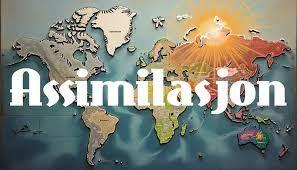Imagine a young immigrant named Lars, who arrives in a bustling Norwegian city from a distant land. His days are filled with the unfamiliar sounds of fjord winds and the scent of fresh lutefisk in the markets. At first, he clings to his native customs, speaking his mother tongue at home and cooking traditional meals that remind him of his roots. But as months turn into years, Lars begins to weave threads of his new surroundings into his life—he learns Norwegian phrases during coffee breaks with colleagues, celebrates Constitution Day with neighbors, and even adopts the local love for cross-country skiing. This subtle transformation, where individual identities blend into the societal fabric, is the essence of assimilasjon. Through Lars's story, we see how personal experiences shape broader cultural shifts, setting the stage for a deeper exploration of this concept.
What is Assimilasjon?
In the realm of sociology and cultural studies, assimilasjon refers to the process by which individuals or groups adopt the customs, values, and behaviors of a dominant culture, often leading to a loss or modification of their original identity. This term, rooted in Latin origins meaning "to make similar," has been a key topic in discussions about immigration and societal harmony, particularly in multicultural nations like Norway.
Historical Roots of Assimilasjon
The concept has evolved over centuries. In the 19th and early 20th centuries, many European countries, including Norway, implemented policies aimed at integrating indigenous populations and immigrants. For instance, the Norwegianization policies targeted the Sami people, encouraging them to adopt Norwegian language and lifestyles. These efforts highlight how assimilasjon can stem from both voluntary choices and enforced measures, often sparking debates on cultural preservation versus unity.
Assimilasjon in Modern Society
Today, assimilasjon manifests in various forms, from language acquisition to social participation. In urban centers, immigrants might enroll in integration courses to learn local norms, fostering a sense of belonging. However, this process isn't always seamless; it can involve challenges like discrimination or identity conflicts, as seen in Lars's initial struggles.
The Benefits and Challenges of Assimilasjon
While assimilasjon promotes social cohesion, it comes with a dual-edged sword. On one hand, it enables economic opportunities and community building; on the other, it risks eroding diverse heritages.
Positive Impacts on Individuals and Communities
Successful assimilasjon can lead to improved access to education, employment, and healthcare. Studies show that integrated immigrants often experience higher life satisfaction and contribute more to the economy. In Norway, programs supporting language learning have helped many newcomers thrive, turning potential divides into strengths.
Potential Drawbacks and Criticisms
Critics argue that forced assimilasjon can suppress minority cultures, leading to resentment or loss of heritage. For example, in educational settings, emphasizing the dominant language might marginalize native dialects. Balancing integration with multiculturalism—often termed "integration" rather than full assimilasjon—has become a preferred approach in progressive policies.
Case Studies from Around the World
Looking globally, the United States' "melting pot" model exemplifies assimilasjon, where diverse groups merge into a unified American identity. In contrast, Canada's "mosaic" approach preserves distinct cultures while encouraging participation. These examples illustrate how contexts influence the outcomes of cultural blending.
Assimilasjon in Norwegian Context
Norway's history with assimilasjon is particularly poignant. From the post-World War II era to recent refugee influxes, the country has navigated integration through welfare systems and community initiatives.
Policies and Initiatives
The Norwegian government promotes assimilasjon through mandatory introduction programs for immigrants, covering language, civics, and job training. These efforts aim to equip newcomers with tools for self-sufficiency, reducing societal barriers.
Cultural Perspectives
In literature and media, assimilasjon is often portrayed through stories of adaptation, much like Lars's narrative. Norwegian authors explore themes of identity in a globalized world, emphasizing empathy and mutual respect.
Strategies for Healthy Assimilasjon
To make assimilasjon beneficial, societies can adopt inclusive strategies that honor diversity.
Promoting Inclusive Education
Schools play a pivotal role by incorporating multicultural curricula, helping children appreciate various backgrounds while learning shared values.
Community Engagement Programs
Local events, such as cultural festivals, encourage interaction, fostering organic assimilasjon without coercion.
Role of Technology and Media
Digital platforms allow for virtual exchanges, aiding remote integration and preserving connections to origins.
Conclusion
Assimilasjon represents a dynamic pathway toward societal unity, as illustrated by Lars's evolving journey from outsider to integrated community member. While it offers pathways to inclusion and growth, it must be approached with sensitivity to avoid cultural erasure. By embracing balanced policies that value both adaptation and diversity, nations can harness the strengths of assimilasjon to build more harmonious futures. Ultimately, understanding this process enriches our global tapestry, reminding us that true integration thrives on respect and shared humanity.



